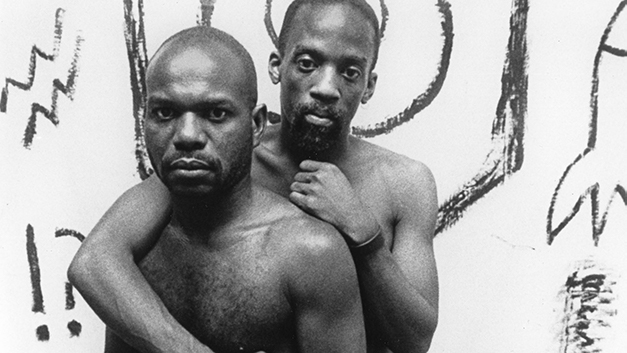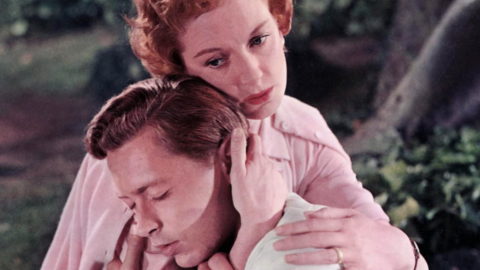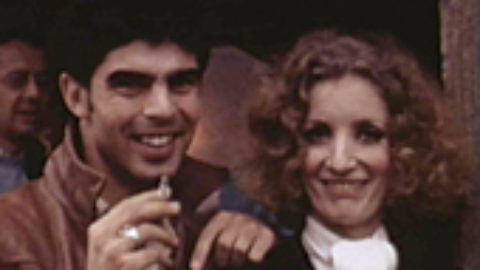Queer & Now & Then: 1991
In this biweekly column, I look back through a century of cinema for traces of queerness, whether in plain sight or under the surface. Read the introductory essay.

It doesn’t take much description to understand why Marlon Riggs’s Tongues Untied was and remains a radical work of American art. Made in the late ’80s, shot on video and just shy of an hour, the film acknowledges the lives, dignity, and complexities of gay black men. But the subject matter, and the fact that it was created by an African American man living with AIDS, are hardly the only reasons for the significance of Tongues Untied, which makes vibrant, shattering art from its essential political cause: putting front and center those who have been historically erased in American culture. Unfortunately, the film is perhaps too often recalled less for its aesthetic daring than for the politically motivated furor that arose around it. Though Tongues Untied premiered in 1989 at the American Film Institute’s Video Festival, and won awards at the Berlin Film Festival and the San Francisco International Lesbian and Gay Film Festival in 1990, it wasn’t until 1991 that Riggs became a figure of controversy and his film a cultural lightning rod.
Invigoratingly shot and edited, with a complexly overlapping, rhythmic soundtrack, Riggs’s self-proclaimed “experimental documentary” fuses elements of dance, poetry, and political journalism to put an unapologetic spotlight on the doubly invisible. As remains true to this day, few things more arouse the hypocrisy and ire of traditional white America than the shameless pride of the marginalized. So in 1991, when Tongues Untied was selected for broadcast on PBS’s nonfiction showcase P.O.V. and therefore set to have its widest audience yet, the conservative and fundamentalist sharks smelled blood and started to circle. In this era of the euphemistically dubbed “culture wars”—of Andres Serrano’s Piss Christ in New York and the Robert Mapplethorpe show at the Corcoran in D.C.—neoconservative politicians were dead-set on making examples of art that they felt was a mockery of government funding; meanwhile, liberal politicians either were not particularly interested in taking up the defense or were joining in the chorus of condemners. Because Riggs was the recipient of a $5,000 grant from the National Endowment for the Arts for Tongues Untied, and because P.O.V. had been granted $250,000 from the NEA that year, the film became a target for high-profile moralist commentators like former Reagan advisor Pat Buchanan and conservative media watchdog groups such as the American Family Association, whose president was quoted in The New York Times as saying, “This will be the first time millions of Americans will have an opportunity to see the kinds of things their tax money is being spent on.”
Riggs himself, in an August 1991 op-ed, wrote that Tongues Untied was characterized as “indecent,” “graphic,” and “obscene.” So what was in this professor/historian/filmmaker’s allegedly foul movie, this work of apparent aggressive offensiveness that so scared the straights and had local public television stations in top markets across the U.S. canceling the broadcast or in some cases delaying it until the kiddies were tucked safely in their beds? As for “shocking” sexual content, in one short montage, we see a slow-motion image of a man removing his shirt before warmly embracing another man; a hand on a bare back; a foot rubbing against a foot; one tender, very brief kiss. As for obscenities, there’s a sequence that approximates the barrage of derogatory homophobic and racist words to which gay and black men have long been subjected, including “punk,” “homo,” “faggot,” “freak,” “motherfucking coon,” “Uncle Tom”—all emanating from disembodied mouths in extreme close-up. Could this language have truly disturbed the fragile sensibilities of the bigots who were out to censor Riggs? (The only true offense in the film is intentional: the use of clips from Eddie Murphy’s homophobic Raw standup routines, with which Riggs reflects upon the ingrained prejudice against gays within the black community.) Rather, the labeling of Tongues Untied as obscene was a convenient way to further marginalize and erase black, gay American culture; that the film, as evident from its title to its final spoken line of narration (“Now I speak and my burden is lightened, lifted, free”), is literally about the artist’s refusal to be further silenced, makes its fate in 1991 too terribly perfect.
By the time Tongues Untied was first screened, Riggs’s continuing struggle to be heard had been compounded by the fact of his sickness: he was diagnosed with HIV in 1989 while working on the film, and had already experienced kidney failure. “Silence is my shield, silence is my cloak, silence is my sword,” Riggs states in voiceover near the beginning of the film—against the image of an undressed man gyrating in a dark nether-space—communicating to viewers the meaning and cost of not speaking out. The film sometimes feels like a dialogue among black men (a cacophony of voices chants “brother to brother, brother to brother” at a rapid pace at the outset) that non-black viewers are being privileged to access; at other times it feels like the film’s black subjects are directly appealing to those who might dare dismiss them, or treat them, knowingly or unknowingly, like an “Endangered Species,” to refer to a title card near the beginning. Sometimes the men—who include late poet and activist Essex Hemphill—look directly into the camera as they tell their stories; at other times Riggs narrates in voiceover the realities of his life as a gay black man. In one passage he muses on the social construction of the rules of attraction, on his longtime fixation on cruising white boys, and how this was related to the systemic absence of black men in gay culture, erotica, and pornography. “I had no history, no reflection,” Riggs intones as he we see him walking through San Francisco’s Castro District, and, then, in one of the film’s most poignant, poetic lines, “I was blind to my brothers’ beauty, but now I see my own.” It’s a sentiment that gets a response at the end of the film with the thunderbolt onscreen text, “Black men loving black men is a revolutionary act”—a political phrase attributed to gay poet Joseph Beam, who died from AIDS-related causes in 1988.
These words, which also appear during the film on a pride parade banner, speak eloquently and definitively to the movie’s consciousness-raising beauty and urgency. Tongues Untied was part of a small subset of remarkable films that premiered between 1989 and 1991 that emphasized queer perspectives from black and/or Latinx communities, including Isaac Julien’s Harlem Renaissance memorial Looking for Langston and Jennie Livingston’s drag ball revelation Paris Is Burning. Riggs’s film (which, as with Livingston’s, also makes space for images from vogue-ing culture) augured a movement towards a more culturally specific kind of American independent cinema, though this ultimately seems to have been mostly swallowed up in the 1990s in the industry’s race toward increasingly marketable and homogenized, Sundance-approved product.
Riggs, on the other hand, would remain uncompromising, continuing to produce nuanced features and shorts that spoke to and from a specific black, queer perspective. His career culminated in Black Is…Black Ain’t (1994), a testament to the sophisticated filmmaking and philosophy that undergirded his work, and an especially poignant experience to watch considering that he died while making it at the tragically young age of 37. Riggs was an artist who was constantly trying to socially and emotionally reconcile his black and gay identities, and he takes it one step further with Black Is…Black Ain’t, effortlessly complicating matters by wrestling with his identity as a black gay man who’s also living with AIDS. Fittingly for a film with so many tangled threads, it crisscrosses, bobs, and weaves among a number of topics, moving back and forth from the interior landscape of one person struggling with a disease that’s also a social stigma to larger, external questions that persist within the black community. At one point, Riggs says in voiceover, “The connection between AIDS and black folks and black folks’ identity is metaphoric; both of them are a struggle against the odds in the face of diversity, in the face of possible extinction . . . How do we keep ourselves together as a people in the face of all our differences? How do we maintain a sense of communal selfhood?” In a cut that speaks to the discursive and selfless nature of Riggs’s work, the film moves from an image of the filmmaker in his hospital bed directly to an Oakland classroom of young African American elementary school students drawing pictures inspired by their lives, and his questions—and the word selfhood—linger over the screen. A dying man and a cheerful class of kids; in Riggs’s film, both seem like images of possibility.
The 30th anniversary screening of Tongues Untied screens at BAM on February 6, as part of Race, Sex & Cinema: The World of Marlon Riggs (February 6–14, 2019).
Michael Koresky is the Director of Editorial and Creative Strategy at Film Society of Lincoln Center; the co-founder and co-editor of Reverse Shot; a frequent contributor to The Criterion Collection; and the author of the book Terence Davies, published by University of Illinois Press.





